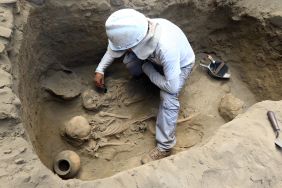Artwork: The Herculaneum Gate in Pompeii, 1799, detail, by Jacob Phillip Hackett. Image Credit: Museum der bildenden Künste, Leipzig.
Archaeology is a modern pursuit, having blossomed over the past two centuries as the discipline speaks to the passions of contemporary life. The desire to discover what has come before in an effort to know the vast and diverse history of humanity compels many to become archaeologists. I can dig it.
Also: Exhibit | Curator Barbara Tannenbaum on “Pyramids & Sphinxes”
The Great Archaeologists, edited by Brian Fagan (Thames & Hudson) presents over 200 years of pioneering research and excavation around the globe from Africa, Asia, the Pacific, the Americas, and Europe. Organized into six thematic chapters including The Antiquity of Humanity, Discoverers of Ancient Civilizations, The Art of Excavation, Decipherers of Ancient Scripts, Discovering World Prehistory, and Thinking About the Past, The Great Archaeologists presents an incomparable survey of the discipline.

Pages from Gabriel de Mortillet’s Musée Préhistorique, 1881. Image Credit: from Gabriel de Mortillet, Musée de Préhistorique
The book features a chapter of Louis Leakey & Mary Leakey, the husband and wife team who discovered the origins of humankind in Africa dating back 3.6 million years ago. This puts things into context. We’re starting from a place of survival, when the human being was built to survive without the comforts of civilization. That we escaped extinction for so long is nothing short of remarkable. Moving forward in time, we journey around the world across time, vistiing some of the greatest empires to ever exist. From the Mayan to the Minoan, the Olmec to Egypt, Troy to Pompeii, each of the civilizations unearthed by archaeologists provides remarkable clues into human history.
American Southwest archaeologist Alfred Kidder observed, “Archaeological digging is a good deal like deep-sea fishing off the New England coast: you never know whether you are going to pull up a cod or a sculpin—often you get nothing at all. But once in a while you will hook a big halibut, and then you are in for a long, long struggle.”

Julio Tello’s posthumous volume on the Chavín civilization, with its characteristic sculpted heads at the site of Chavín de Huántar. Image Credit: from Julio C. Tello, Chavin, 1960
The Great Archaeologists showcases the best of the best in the history of the field. Witness Robert Koldewey’s excavation of Nebuchadnezzar’s Babylon, Howard Carter’s opening of Tutankhamun’s tomb, still captivating more than a century after they were unearthed, and Alexey Oladnikov and Sergey Semenov’s discovery of Neanderthal Man in the mid-twentieth century. Each find is more amazing than the next.
As Julio Tello, the Father of Peruvian Archaeology, revealed, “The first time I held in my hands the skull of an Incan mummy to study, I felt a profound emotion That skull, honored by the centuries, connected with my heart and made me feel the message of the race whose blood ran through my veins. From that moment I became an anthropologist.”

William Stukeley’s Prospect of Camalet Castle, 15 August 1723.
(Cadbury Castle, Dorset).. Image credit: from William Stukeley, Itinerarium Curiosum, 1776
Miss Rosen is a New York-based writer, curator, and brand strategist. There is nothing she adores so much as photography and books. A small part of her wishes she had a proper library, like in the game of Clue. Then she could blaze and write soliloquies to her in and out of print loves.




